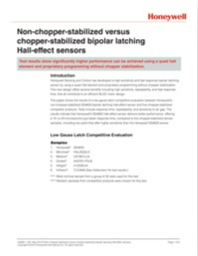Non-chopper-stabilized versus chopper-stabilized bipolar latching Hall-effect sensors
This paper shows the results of a low gauss latch competitive evaluation between Honeywell's non-chopper-stabilized SS460S bipolar latching Hall-effect sensor and five chopper-stabilized competitor products. Tests include response time, repeatability, and sensitivity to air gap.
The results indicate that Honeywell's SS460S Hall-effect sensor delivers better performance, offering a 10- to 20-microsecond (µs) faster response time, compared to the chopper-stabilized sensor samples, including two parts that offer higher sensitivity than the Honeywell SS460S sensor.
Download this whitepaper to learn more.
Read More
By submitting this form you agree to Honeywell contacting you with marketing-related emails or by telephone. You may unsubscribe at any time. Honeywell web sites and communications are subject to their Privacy Notice.
By requesting this resource you agree to our terms of use. All data is protected by our Privacy Notice. If you have any further questions please email dataprotection@techpublishhub.com
Related Categories: Switches


More resources from Honeywell

Non-chopper-stabilized versus chopper-stabilized bipolar latching Hall-effect sensors
This paper shows the results of a low gauss latch competitive evaluation between Honeywell's non-chopper-stabilized SS460S bipolar latching Hall-ef...

Effectively Using Pressure, Load, and Torque Sensors with Today’s Data Acquisition Systems
Utilizing high quality pressure, load, and torque sensors, and selecting the correct design and installation for the application are critical to en...

Load cell use in aerospace ground and flight test applications
The use of load cells is prevalent in many aerospace ground and flight test applications. In considering this technology, it is important to unders...
